Menus
- The little one was a shock
- LE for little engine
- All you have to do is pull the clutch
- Low compression, tame valve timing
- Brakes of the Velocette LE can be easily controlled
- Technical data Velocette LE
- Hermaphrodite
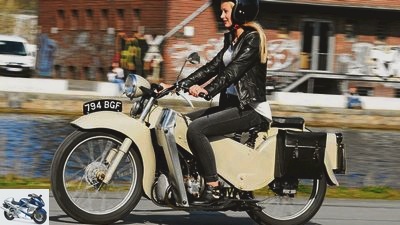
Siemer
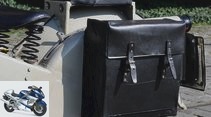
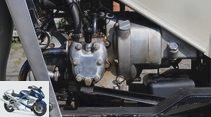

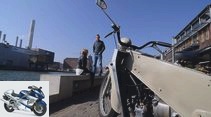
26th photos

Siemer
1/26
As early as 1913, the owners who had emigrated from Germany had been producing both solid and sporty motorcycles under the name Velocette, powerful single-cylinder engines became a trademark, 350 cc road racers dominated the European and World Cups before and even more immediately after the war and achieved numerous TT victories.
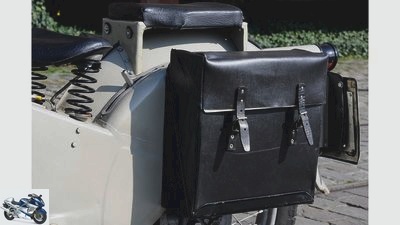
Siemer
2/26
The side pockets were also available from the factory.
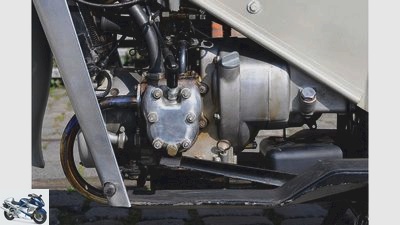
Siemer
3/26
The longitudinally installed, liquid-cooled two-cylinder four-stroke boxer engine.
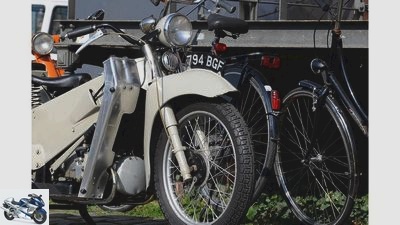
Siemer
4/26
At that time, however, the auto boom should not be underestimated.
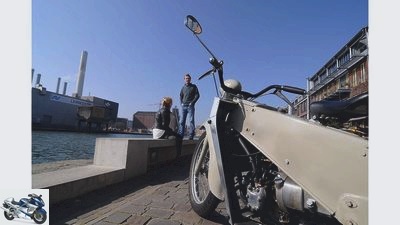
Siemer
5/26
The maximum speed of the Velocette LE II is around 80 km / h.
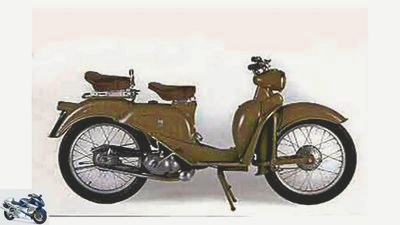
Siemer
6/26
There were of course alternatives to the Velocette LE II. Two-stroke: Aermacchi N 125 from 1951.
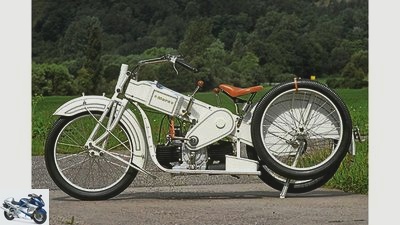
Siemer
7/26
With a Maybach engine: Mars from 1920.

Siemer
8/26
Single-sided swinger: Guzzi Galletto, from 1950.
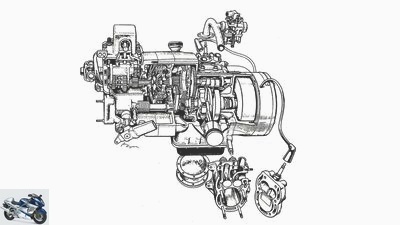
Siemer
9/26
Veloces little engine – a demanding construction. Here is the 150 cm³ variant without an oil filter. But with Amal throttle valve carburetor, which was replaced on the Mk II of the slide type 363. The ignition and Lima are in the front under the pot lid, just like with BMW.
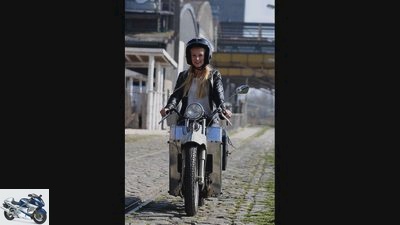
Siemer
10/26
The LE rocks casually over pitted surfaces and can be safely guided on the oncoming handlebars. It never gets sparkling.
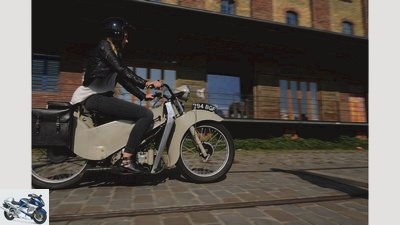
Siemer
11/26
But she’s never bitchy either. No swallowing, no jerking or bucking.
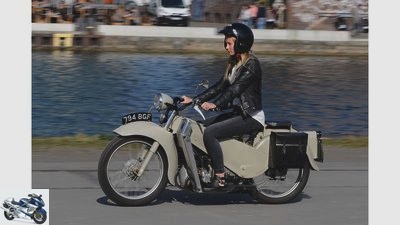
Siemer
12/26
With an emphasis on moderate, it increases evenly, does not shy away from higher speeds, even needs it in the second, so that the connection is correct in the third and the 70 km / h are cracked.

Siemer
13/26
On the sign in the flap of the tool and glove compartment, the manufacturer kindly asks you to observe the maximum speed of 5000 rpm.
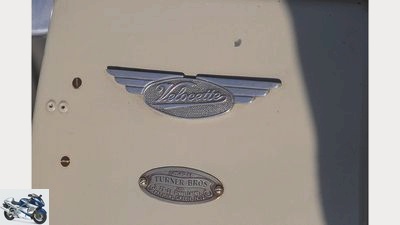
Siemer
14/26
The Velocette LE II can convince with its reliability.

Siemer
15/26
During the war, Veloce technicians had already gathered ideas for a truly mass-market vehicle and created a concept that they followed up on in 1945.
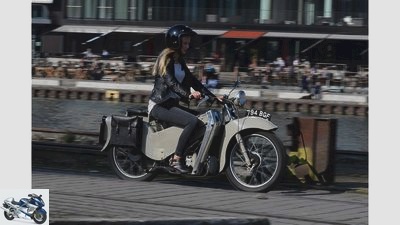
Siemer
16/26
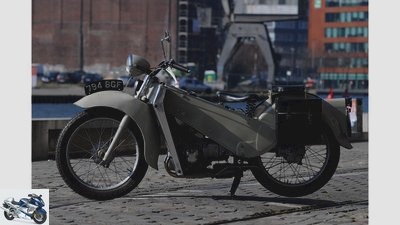
Siemer
17/26
A water-cooled two-cylinder boxer engine with 150 cm³ hangs under a massive box frame made of sheet steel, behind it the locked, manually shifted three-speed gearbox, and finally a shaft drive to the rear wheel housed in the left swing arm.
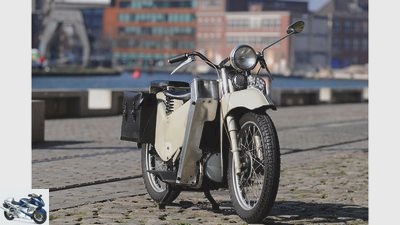
Siemer
18/26
Too bad that the Velocette LE at 126 cost exactly £ 50 more than a BSA Bantam 125.
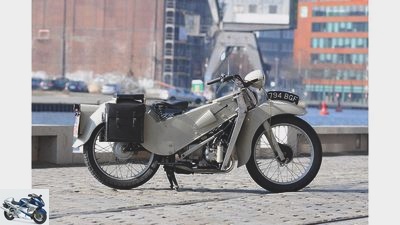
Siemer
19/26
The metal box was reminiscent of the German Mars from the 1920s, but what else? In sum, the purest miracle, never seen before.
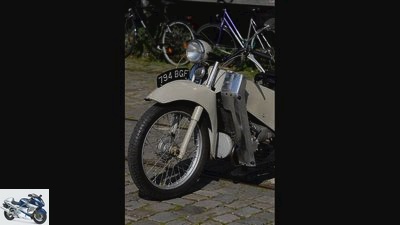
Siemer
20/26
By the end of 1955, only 23,000 LE had been produced, while many less thought-out motorcycles and scooters had become mega-sellers.
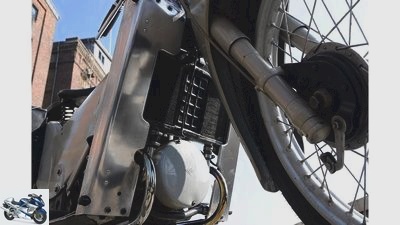
Siemer
21/26
Under the gearbox, the two elbows flow into a boxy silencer. Almost like today.
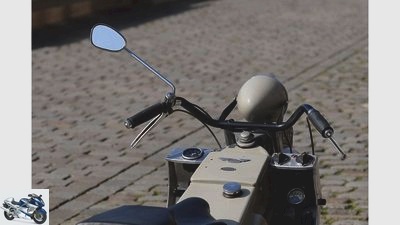
Siemer
22/26
A very clear arrangement of instruments, levers and switches welcomes the LE driver, and the cooling water thermometer at the bottom right.
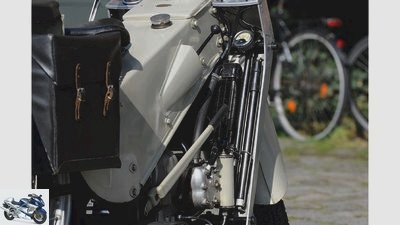
Siemer
23/26
The smooth-running start lever and the well-guided gearshift are ideally at hand. Also noteworthy is the air pump stowed far right in the leg shield next to the radiator.

Siemer
24/26
For the Mk II with the 192 cm³ engine, which was produced from 1950, not only had the oil circuit been improved, it also had a distinctive oil filter on the right cylinder.
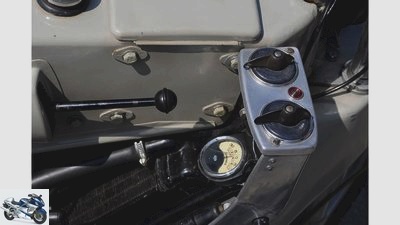
Siemer
25/26
The lever of the Velocette LE II.
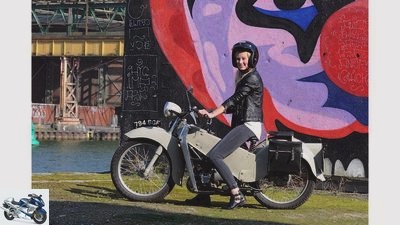
Siemer
26/26
There are said to have been tons of British bobbies who mourned their trusty patrol wheel, which according to the police easily managed over 60,000 miles, for decades. Somebody has to understand the little Velocette.
On the move with the Velocette LE II
The little one was a shock
Content of
It was to become a motorcycle for everyman, and the Velocette LE actually turned out to be extremely humane. Still – or because of it? – she remained a mystery to her contemporaries.
A.When the Second World War was finally over, people paused and wondered what they had been doing before. It occurred to most of them that they had dreamed of a little more prosperity and social participation. So they shook each other three times and picked up from that point. Almost all manufacturers thought it was great, especially motorcycle industrialists benefited from this new start and now instead of bikes for detectors sold 125cc for malocher. Some visionaries, however, saw more beginnings at that time, discovered space for new ideas, and these certainly included those responsible at the traditional motorcycle company Veloce Ltd. in Hall Green, a suburb of Birmingham.
Buy complete article
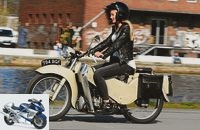
On the move with the Velocette LE II
The little one was a shock
Velocette just as solid as sporty motorcycles, mighty single-cylinder became a trademark, 350 cc road racers dominated the European and world championships before and even more immediately after the war and achieved several TT victories. The Goodman family (formerly Gutgemann) wanted to sacrifice this wonderful business and marketing model because they believed in a new era of motorcycling, in which sport was no longer what counted, but comfort, in which there was no banging or banging and in which no one would anymore Made hands dirty.
LE for little engine
During the war, Veloce technicians had already collected ideas for a truly mass-market vehicle and created a concept that they followed up on in 1945: a water-cooled two-cylinder boxer engine with 150 cm³ hangs under a massive box frame made of sheet steel, behind which is the one that is blocked and switched by hand Three-speed transmission, finally a shaft drive to the rear wheel housed in the left swing arm. Leg shields and running boards increase the weather protection, stereo suspension struts and telescopic fork take care of comfort. At the Earls Court Show in London, this design premiered in 1948, the name: LE, for little engine. The little one was a real shocker, was the theme of the show, left no one indifferent. The metal box was reminiscent of the German Mars from the 1920s, but what else? In sum, the purest miracle, never seen before.
Veloce was able to explain every single detail exactly. Why boxer engine? Because with its low vibrations, it is not only easy on the driver, but also on the frame. A LE should last forever. Water cooling? Firstly, it dampens the engine noise and secondly, air cooling would have required much larger cutouts in the leg shields, so less weather protection would have been required. Side valves? Cylinder heads with hanging valves would have become more expansive. Heads made of light metal? They can handle more heat and are lighter. Multi-disc clutch? A single disc would have required a stronger spring and thus greater hand strength. Cardan drive? The target customers were neither willing nor able to properly supply a chain. Manual transmission? This audience – especially its female part – did not want to scratch their shoes on a lever. For the same reason, the Velocette LE does not have a kick starter, but a long lever on the right side of the engine that is pulled by hand; So that nobody has to pull several times, Amal supplied a carburetor that was specially trimmed for good starting behavior.
All you have to do is pull the clutch
It doesn’t stop there: As with the large Velocettes, the upper pivot point of the shock absorber can be moved to adjust the suspension to different loads. If you turn the springs of the swinging saddle to the left, you release them from their seat and can then fold the saddle forward to supply the battery underneath. If you loosen the hoses of the thermosiphon cooling system and a few screws, you can separate the entire body including the front section from the engine swing arm unit and then repair it with great ease. When jacking up, friction-stopping rubbers under the feet of the main stand are popular; when the start lever is pulled, this main stand folds in automatically. In addition, the start lever acts directly on the output shaft of the engine, so it is sufficient to simply pull the clutch before starting, a gear can remain in place. In the box frame is not only the tank, but also a friendly glove compartment, and yes, the side pockets were also ex works.
Too bad that the Velocette LE at 126 cost exactly 50 pounds more than a BSA Bantam 125. Too bad that people like to stick to the familiar, even if – like back then with the motorcycle – they only had 50 years to get used to. The Goodmans quickly realized that they had to further develop the previously successful single-cylinder. Be that as it may: Already in the 7/1956 issue of MOTORRAD, Dr. Paul Simsa that by the end of the previous year only 23,000 LE had been produced, while many less well thought-out motorcycles and scooters had become mega-sellers. After paying tribute to a number of details designed for longevity in the further course of a true hymn of praise, rejoicing at the handling and praising the exemplary economy, the then still quite young fine spirit concludes with the conclusion: “When I retire and only follow acceleration curves with a philosophical smile, then hopefully there will still be a LE to buy somewhere. “
Low compression, tame valve timing
Martin Stegemann was not drawn to the bizarre Velocette LE from his own experience. But at least from his own experience, because wherever he was studying, an employee whirred to work with the LE every day and in summer and winter, parked it in sight, drove back home in the evening. Like a ritual, and its consistency had to impress at a time when even precision mechanics apprentices repeatedly struggled with the inadequacies of their motorcycles. Years ago, Stegemann was able to acquire an unrestored and original Velocette LE of the second series. But although its engine has 192 cm³ thanks to its larger bore and has eight instead of six horsepower, it is the cheerful supporting actress in the collection of its more sporty owner. He willingly passes the handlebars on.
Two pulls on the start lever, and indeed: you have to listen carefully to notice the awakened boxer. First gear in the front left, a little gas, and the little flat twin pushes with an almost touching gentleness. Low compression, tame valve timing – how relaxing it can be! The sitting position is wonderfully relaxed, not with the knees drawn up and pressed together as on many scooters, but resting and upright like on an old Harley. You can’t support yourself with your legs like that, of course, but – unlike on badly sprung Harleys – you don’t miss it at all. The Velocette LE rocks casually over pitted surfaces and can be safely guided on the oncoming handlebar. It never gets sparkling. But she’s never bitchy either. No swallowing, no jerking or bucking. With an emphasis on moderate, it increases evenly, does not shy away from higher speeds, even needs it in the second, so that the connection is correct in the third and the 70 km / h are cracked.
Brakes of the Velocette LE can be easily controlled
Both brakes can be dosed well, in combination their effect is sufficient even for today’s bustling city, and that is what Dr. Simsa comes into play: How right the man was when he called the Velocette LE a truly modern means of transport. Alternatives came with the Galletto from Moto Guzzi or the N 125 from Aermacchi, all three of which were overtaken by the car boom and they were forgotten. Also from Simsa: The journalist, who died in 2013 at the age of 88, spent his last motorcycle days with a Benelli 250 2C. And Martin Stegemann likes to leave his LE to the curious daughters. However, there are supposed to have been tons of British bobbies who mourned their trusty patrol wheel, which according to the police easily managed over 60,000 miles, for decades. Somebody has to understand the little Velocette.
Technical data Velocette LE
Siemer
At that time, however, the auto boom should not be underestimated.
engine
Longitudinally installed, liquid-cooled two-cylinder four-stroke boxer engine, a camshaft below, two vertical valves each, bore x stroke 50 x 49 mm, compression 7: 1, displacement 192 cm³, power 8 HP at 5000 / min.
Power transmission
Multi-disc dry clutch, three-speed gearbox, cardan drive.
landing gear
Box frame made of sheet steel profiles with welded rear fender, screwed-on steering head, telescopic fork at the front, rear swing arm with spring struts, wire-spoke wheels with steel rims, tires 3.00-19, 127 mm simplex half-hub drum brakes at the front and rear.
Mass and weight: Dry weight 113 kg, tank capacity 7.4 l
Mileage: Top speed around 80 km / h
Hermaphrodite
Siemer
With a Maybach engine: Mars from 1920.
The triumph of the scooter in the early 1950s was not a decided thing: like Veloce, some Italian companies brought out smart hermaphrodites, all of which, thanks to really large wheels, are significantly more stable than the wobbly scooters. Technically superior, they too ultimately failed because of the public’s taste. Just like the German Mars with its box frame around three decades earlier.
Related articles
-
On the move: BMW R 26 and Simson AWO 425 S.
Fisherman In comparison: BMW R 26 and Simson AWO 425 S. Same parts – BMW R 26 and Simson AWO 425 S. Content of Because they didn’t dare dream of their…
-
wolf On the move: Hercules K 125 T The Nurnbergerle Content of At that time the Hercules K 125 T was light home cooking; if not exactly the dream…
-
On the move with the Kawasaki Z 650 family
wolf 38 photos wolf 1/38 A very special family outing – on the go with four different Kawasaki Z 650 models. wolf 2/38 The B1 drives beautifully…
-
On the move with the Honda XL 600 V Transalp
Volker Rost 26th photos Peoples rust 1/26 Honda XL 600 V Transalp. Peoples rust 2/26 Until then, Honda had not had any luck with two-cylinder enduros….
-
On the move with the Honda CBX 550 F2
Fred Siemer, Archive, Honda 18th photos Fred Siemer, Archive, Honda 1/18 On the move with the Honda CBX 550 F2. Fred Siemer, Archive, Honda 2/18 The…
-
On the move with the BMW R 69 S.
Gargolov 30th photos Gargolov 1/30 Gargolov 2/30 Gargolov 3/30 Gargolov 4/30 Gargolov 5/30 Gargolov 6/30 Gargolov 7/30 Gargolov 8/30 Gargolov 9/30…
-
On the move with the Muller-Yamaha XS 400T
Fred Siemer 16 photos Fred Siemer 1/16 Yamaha XS 400T Fred Siemer 2/16 Yamaha XS 400T. Fred Siemer 3/16 Yamaha XS 400T. Fred Siemer 4/16 The compact twin…
-
Siemer On the move: Moto Guzzi V7 Steam announcement Content of No teeth in the mouth, but La Paloma whistles: This is what it looked like when Moto…
-
On the move: Benelli 750 Sei, Honda CBX 1000, Kawasaki Z 1300
Bilski 17th photos Bilski 1/17 Who is the widest in the whole country? The angle of spread of the driver’s legs provide information. Bilski 2/17 With…
-
On the move with Kawasaki GPZ 900 R and Yamaha FJ 1100
fact 39 photos fact 1/39 Hurry with a while, always slowly with the young horses – sayings like these were definitely not up for debate when the new,…